2014 FIAT GRANDE PUNTO ACTUAL fuel
[x] Cancel search: fuelPage 132 of 216

131
SAFETY
STARTING
AND DRIVING
IN AN
EMERGENCY
SERVICE
AND CARE
TECHNICAL
SPECIFICATIONS
INDEX
CONTROLS
AND DEVICES
WARNING
LIGHTS AND
MESSAGES
GENERIC WARNING
(amber)
The warning light turns on in the follow-
ing circumstances:
Engine oil pressure sensor fault
The warning light turns on when a failure
is detected in the engine oil pressure sen-
sor. Go to a Fiat Dealership to have the
fault fixed as soon as possible.
Start&Stop fault
(for versions/markets where provided)
The warning light comes on when a
Start&Stop failure is detected.
A specific message is displayed on certain
versions.
Exterior lights fault
See the section on warning light
6.
Fuel cut-off switch tripped
The warning light comes on when the
fuel cut-off switch is triggered.
The display will show a specific message.
è
EXTERIOR LIGHTS
FAULT (amber)
The warning light comes on (on some ver-
sions) when a failure is detected in one
of the following lights:
– sidelights
– brake lights
– rear fog lights
– direction indicators
– number plate lights
– daytime running lights (DRL) (for ver-
sions/markets, where provided)
The failure relating to these lights could
be: one or more blown bulbs, a blown
protection fuse or a break in the electri-
cal connection.
On certain versions warning light èturns
on as an alternative.
A specific message is displayed on certain
versions.
W
REAR FOG LIGHTS
(amber)
The light comes on when the rear fog
lights are turned on.
4
CAR PROTECTION
SYSTEM FAULT
– FIAT CODE
(amber)
The warning light switching on (on some
versions, with the displaying of a message)
signals the failure of the Fiat Code system
or, if installed, of the alarm system: in this
case, contact a Fiat Dealership as soon as
possible.
Y
123-134 ACTUAL 1ed EN 31-08-2010 9:24 Pagina 131
Page 137 of 216

136
SAFETY
STARTING
AND DRIVING
WARNING
LIGHTS AND
MESSAGES
SERVICE
AND CARE
TECHNICAL
SPECIFICATIONS
INDEX
CONTROLS
AND DEVICES
IN AN
EMERGENCY
STARTING THE ENGINE
EMERGENCY START-UP
If the instrument panel warning light
Ystays on permanently, contact a Fiat
Dealership immediately.
JUMP STARTING fig. 1
If the battery is flat, the engine may be
started using an auxiliary battery with an
equal or slightly higher capacity than the
flat one. Proceed as follows to start the car:
❒connect the positive terminals (+near
the terminal) of the two batteries with
a jump lead;
❒with a second lead, connect the nega-
tive terminal (–) of the auxiliary battery
to an earthing point
Eon the engine or
the gearbox of the car to be started;
❒start the engine.
❒when the engine has been started, fol-
low the sequence above in reverse or-
der to remove the leads.
If after a few attempts the engine does not
start, do not keep trying but contact a Fiat
Dealership.IMPORTANT Do not directly connect the
negative terminals of the two batteries:
sparks could ignite explosive gas released
from the battery. If the auxiliary battery is
installed on another car, prevent acciden-
tal contact between metallic parts of the
two cars.
IMPORTANT For cars with Start&Stop
system, in case of starting by booster bat-
tery, refer to "Dashboard and controls"
chapter, paragraph "Start&Stop system".
BUMP STARTING
Never bump start the engine by pushing,
towing or driving downhill. This could
cause fuel to flow into the catalytic con-
verter and damage it beyond repair.
IMPORTANT Remember that the brake
booster and the power steering system
are not active until the engine is started,
so you will need to apply much more force
to the brake pedal or steering wheel.
This procedure must be per-
formed by expert personnel
because incorrect actions may cause
considerable electrical discharge. Fur-
thermore, battery fluid is poisonous
and corrosive: avoid contact with skin
and eyes. Keep naked flames and lit
cigarettes away from the battery. Do
not create sparks.
WARNING
fig. 1F0M0414m
135-166 ACTUAL 1ed EN 26-07-2010 16:00 Pagina 136
Page 161 of 216
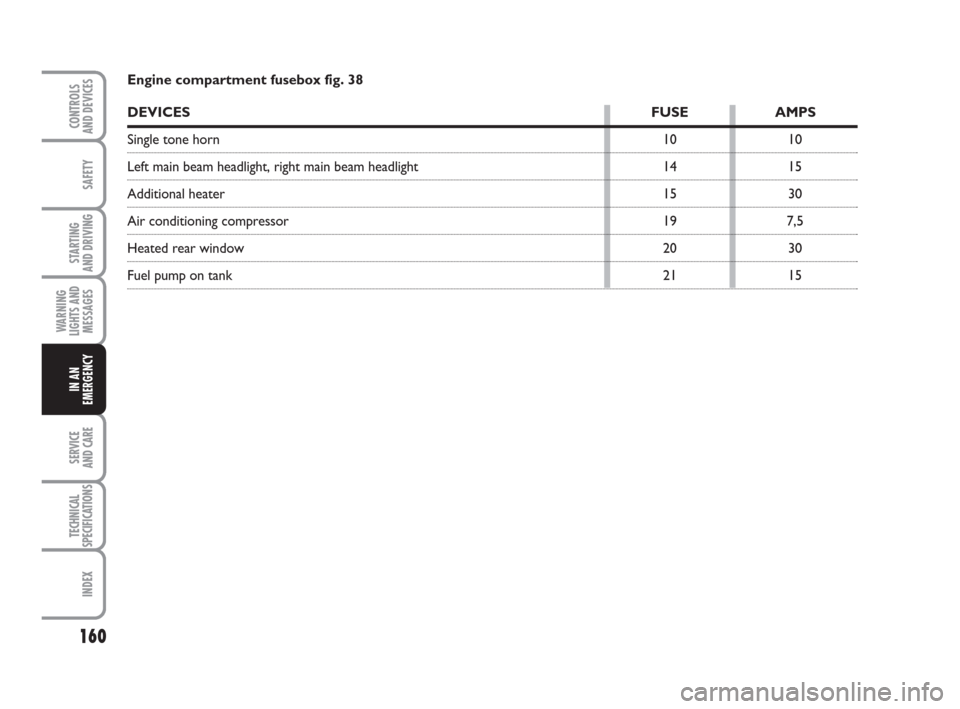
160
SAFETY
STARTING
AND DRIVING
WARNING
LIGHTS AND
MESSAGES
SERVICE
AND CARE
TECHNICAL
SPECIFICATIONS
INDEX
CONTROLS
AND DEVICES
IN AN
EMERGENCY
Engine compartment fusebox fig. 38
DEVICESFUSE AMPS
Single tone horn
Left main beam headlight, right main beam headlight
Additional heater
Air conditioning compressor
Heated rear window
Fuel pump on tank10
14
15
19
20
2110
15
30
7,5
30
15
135-166 ACTUAL 1ed EN 26-07-2010 16:00 Pagina 160
Page 170 of 216
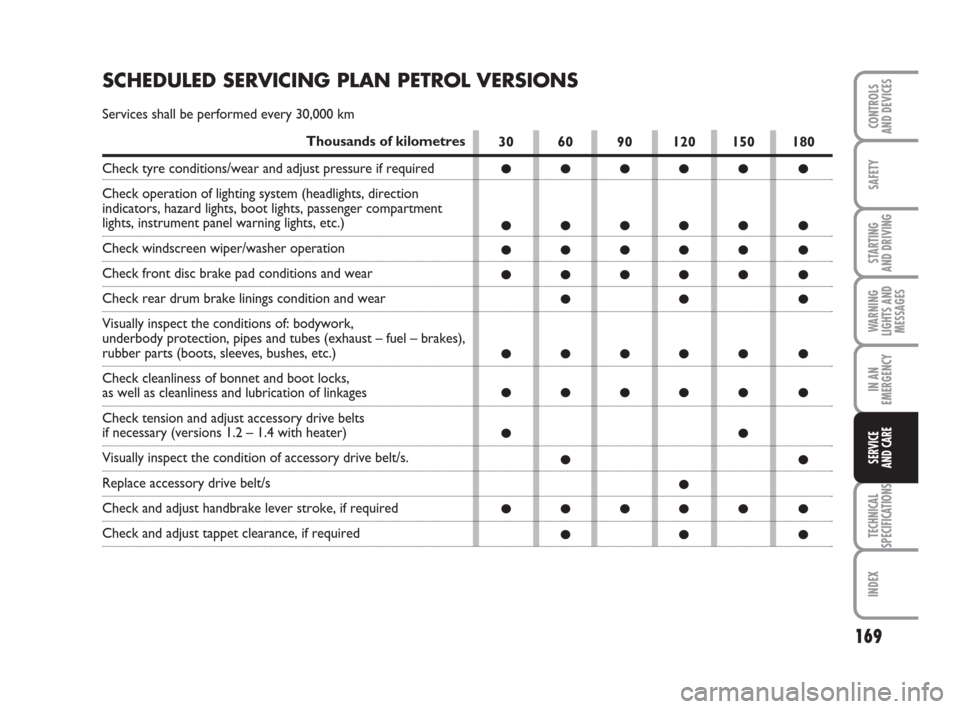
169
SAFETY
STARTING
AND DRIVING
WARNING
LIGHTS AND
MESSAGES
IN AN
EMERGENCY
TECHNICAL
SPECIFICATIONS
INDEX
CONTROLS
AND DEVICES
SERVICE
AND CARE
30 60 90 120 150 180
●●●●● ●
●●●●● ●
●●●●● ●
●●●●● ●
●● ●
●●●●● ●
●●●●● ●
●●
●●
●
●●●●● ●
●● ●
SCHEDULED SERVICING PLAN PETROL VERSIONS
Services shall be performed every 30,000 km
Thousands of kilometres
Check tyre conditions/wear and adjust pressure if required
Check operation of lighting system (headlights, direction
indicators, hazard lights, boot lights, passenger compartment
lights, instrument panel warning lights, etc.)
Check windscreen wiper/washer operation
Check front disc brake pad conditions and wear
Check rear drum brake linings condition and wear
Visually inspect the conditions of: bodywork,
underbody protection, pipes and tubes (exhaust – fuel – brakes),
rubber parts (boots, sleeves, bushes, etc.)
Check cleanliness of bonnet and boot locks,
as well as cleanliness and lubrication of linkages
Check tension and adjust accessory drive belts
if necessary (versions 1.2 – 1.4 with heater)
Visually inspect the condition of accessory drive belt/s.
Replace accessory drive belt/s
Check and adjust handbrake lever stroke, if required
Check and adjust tappet clearance, if required
167-186 ACTUAL 1ed EN 27-07-2010 10:30 Pagina 169
Page 172 of 216
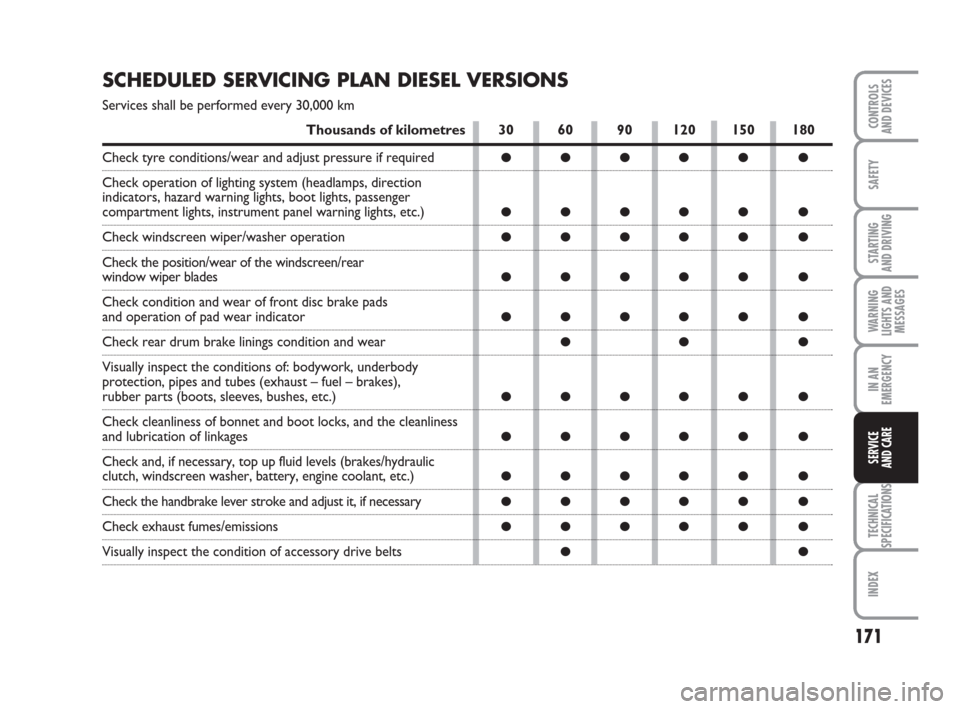
171
SAFETY
STARTING
AND DRIVING
WARNING
LIGHTS AND
MESSAGES
IN AN
EMERGENCY
TECHNICAL
SPECIFICATIONS
INDEX
CONTROLS
AND DEVICES
SERVICE
AND CARE
SCHEDULED SERVICING PLAN DIESEL VERSIONS
Services shall be performed every 30,000 km
30 60 90 120 150 180
●●●●● ●
●●●●● ●
●●●●● ●
●●●●● ●
●●●●● ●
●● ●
●●●●● ●
●●●●● ●
●●●●● ●
●●●●● ●
●●●●● ●
●●
Thousands of kilometres
Check tyre conditions/wear and adjust pressure if required
Check operation of lighting system (headlamps, direction
indicators, hazard warning lights, boot lights, passenger
compartment lights, instrument panel warning lights, etc.)
Check windscreen wiper/washer operation
Check the position/wear of the windscreen/rear
window wiper blades
Check condition and wear of front disc brake pads
and operation of pad wear indicator
Check rear drum brake linings condition and wear
Visually inspect the conditions of: bodywork, underbody
protection, pipes and tubes (exhaust – fuel – brakes),
rubber parts (boots, sleeves, bushes, etc.)
Check cleanliness of bonnet and boot locks, and the cleanliness
and lubrication of linkages
Check and, if necessary, top up fluid levels (brakes/hydraulic
clutch, windscreen washer, battery, engine coolant, etc.)
Check the handbrake lever stroke and adjust it, if necessary
Check exhaust fumes/emissions
Visually inspect the condition of accessory drive belts
167-186 ACTUAL 1ed EN 27-07-2010 10:30 Pagina 171
Page 173 of 216
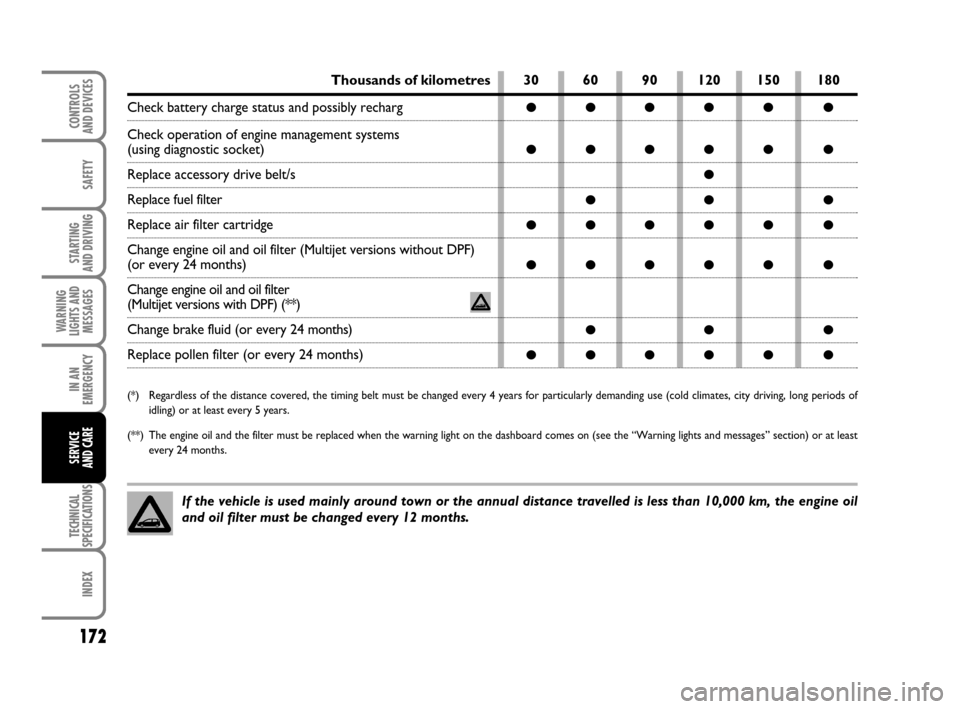
172
SAFETY
STARTING
AND DRIVING
WARNING
LIGHTS AND
MESSAGES
IN AN
EMERGENCY
TECHNICAL
SPECIFICATIONS
INDEX
CONTROLS
AND DEVICES
SERVICE
AND CARE
Thousands of kilometres
Check battery charge status and possibly recharg
Check operation of engine management systems
(using diagnostic socket)
Replace accessory drive belt/s
Replace fuel filter
Replace air filter cartridge
Change engine oil and oil filter (Multijet versions without DPF)
(or every 24 months)
Change engine oil and oil filter
(Multijet versions with DPF) (**)
Change brake fluid (or every 24 months)
Replace pollen filter (or every 24 months)
(*) Regardless of the distance covered, the timing belt must be changed every 4 years for particularly demanding use (cold climates, city driving, long periods of
idling) or at least every 5 years.
(**) The engine oil and the filter must be replaced when the warning light on the dashboard comes on (see the “Warning lights and messages” section) or at least
every 24 months.
If the vehicle is used mainly around town or the annual distance travelled is less than 10,000 km, the engine oil
and oil filter must be changed every 12 months.
30 60 90 120 150 180
●●●●● ●
●●●●● ●
●
●● ●
●●●●● ●
●●●●● ●
●● ●
●●●●● ●
167-186 ACTUAL 1ed EN 18-01-2011 14:40 Pagina 172
Page 174 of 216
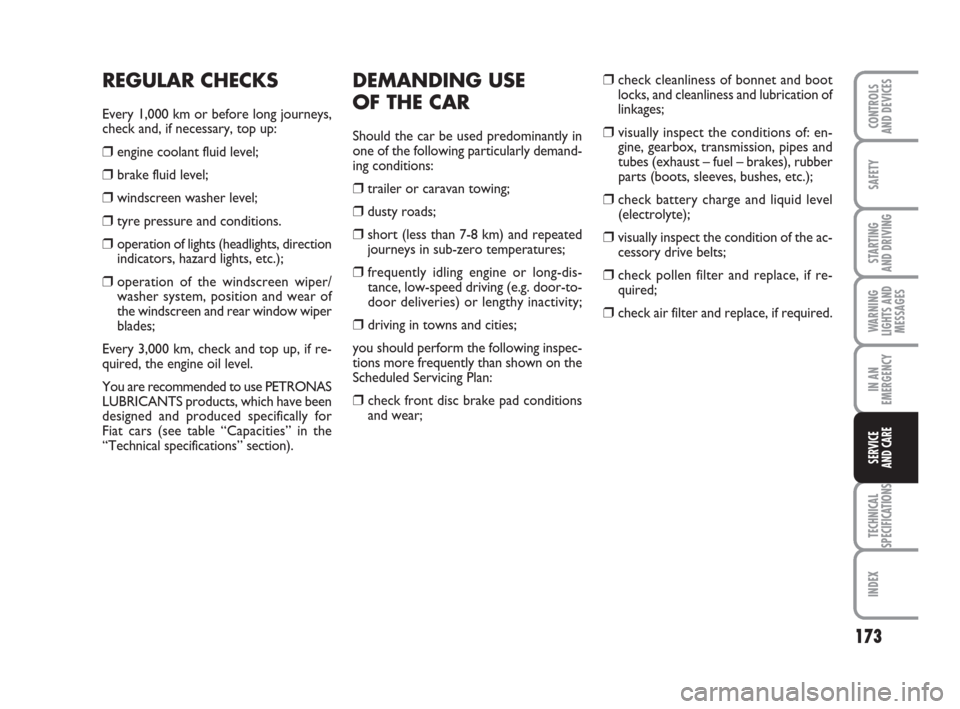
173
SAFETY
STARTING
AND DRIVING
WARNING
LIGHTS AND
MESSAGES
IN AN
EMERGENCY
TECHNICAL
SPECIFICATIONS
INDEX
CONTROLS
AND DEVICES
SERVICE
AND CARE
DEMANDING USE
OF THE CAR
Should the car be used predominantly in
one of the following particularly demand-
ing conditions:
❒trailer or caravan towing;
❒dusty roads;
❒short (less than 7-8 km) and repeated
journeys in sub-zero temperatures;
❒ frequently idling engine or long-dis-
tance, low-speed driving (e.g. door-to-
door deliveries) or lengthy inactivity;
❒ driving in towns and cities;
you should perform the following inspec-
tions more frequently than shown on the
Scheduled Servicing Plan:
❒ check front disc brake pad conditions
and wear;
❒check cleanliness of bonnet and boot
locks, and cleanliness and lubrication of
linkages;
❒ visually inspect the conditions of: en-
gine, gearbox, transmission, pipes and
tubes (exhaust – fuel – brakes), rubber
parts (boots, sleeves, bushes, etc.);
❒check battery charge and liquid level
(electrolyte);
❒visually inspect the condition of the ac-
cessory drive belts;
❒check pollen filter and replace, if re-
quired;
❒check air filter and replace, if required.
REGULAR CHECKS
Every 1,000 km or before long journeys,
check and, if necessary, top up:
❒engine coolant fluid level;
❒brake fluid level;
❒windscreen washer level;
❒tyre pressure and conditions.
❒operation of lights (headlights, direction
indicators, hazard lights, etc.);
❒operation of the windscreen wiper/
washer system, position and wear of
the windscreen and rear window wiper
blades;
Every 3,000 km, check and top up, if re-
quired, the engine oil level.
You are recommended to use PETRONAS
LUBRICANTS products, which have been
designed and produced specifically for
Fiat cars (see table “Capacities” in the
“Technical specifications” section).
167-186 ACTUAL 1ed EN 27-07-2010 10:30 Pagina 173
Page 183 of 216
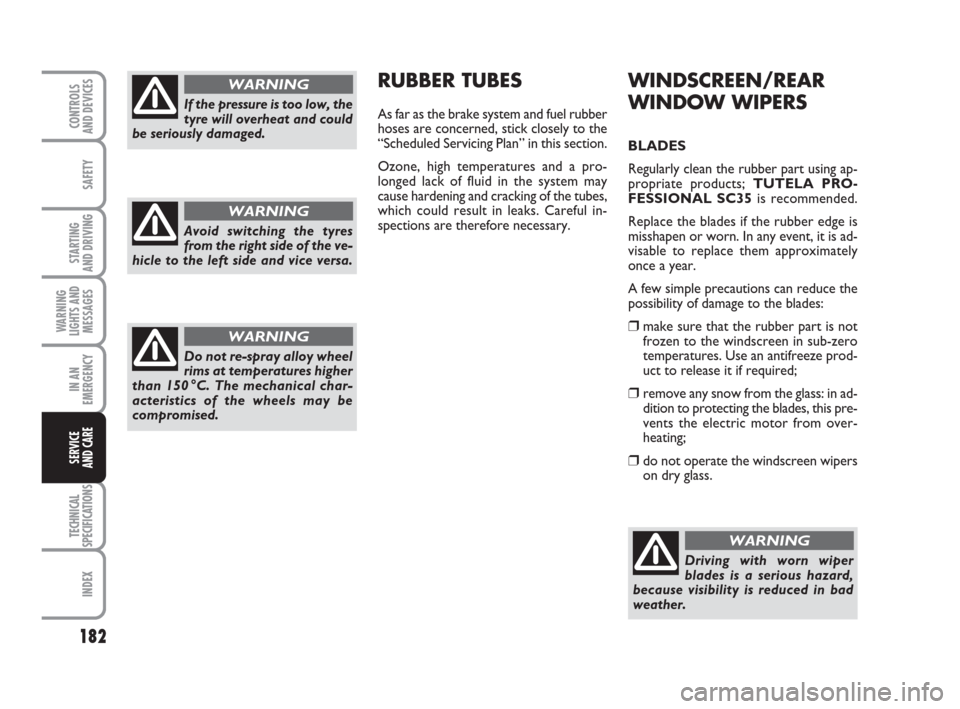
182
SAFETY
STARTING
AND DRIVING
WARNING
LIGHTS AND
MESSAGES
IN AN
EMERGENCY
TECHNICAL
SPECIFICATIONS
INDEX
CONTROLS
AND DEVICES
SERVICE
AND CARE
WINDSCREEN/REAR
WINDOW WIPERS
BLADES
Regularly clean the rubber part using ap-
propriate products; TUTELA PRO-
FESSIONAL SC35is recommended.
Replace the blades if the rubber edge is
misshapen or worn. In any event, it is ad-
visable to replace them approximately
once a year.
A few simple precautions can reduce the
possibility of damage to the blades:
❒make sure that the rubber part is not
frozen to the windscreen in sub-zero
temperatures. Use an antifreeze prod-
uct to release it if required;
❒remove any snow from the glass: in ad-
dition to protecting the blades, this pre-
vents the electric motor from over-
heating;
❒do not operate the windscreen wipers
on dry glass.
Driving with worn wiper
blades is a serious hazard,
because visibility is reduced in bad
weather.
WARNING
RUBBER TUBES
As far as the brake system and fuel rubber
hoses are concerned, stick closely to the
“Scheduled Servicing Plan” in this section.
Ozone, high temperatures and a pro-
longed lack of fluid in the system may
cause hardening and cracking of the tubes,
which could result in leaks. Careful in-
spections are therefore necessary.If the pressure is too low, the
tyre will overheat and could
be seriously damaged.
WARNING
Avoid switching the tyres
from the right side of the ve-
hicle to the left side and vice versa.
WARNING
Do not re-spray alloy wheel
rims at temperatures higher
than 150 °C. The mechanical char-
acteristics of the wheels may be
compromised.
WARNING
167-186 ACTUAL 1ed EN 27-07-2010 10:30 Pagina 182